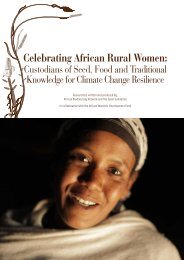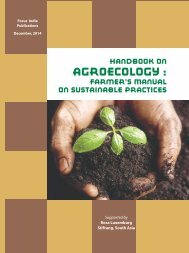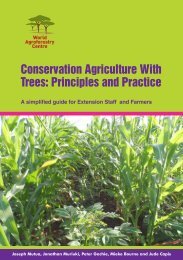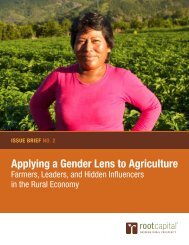1t0SC7l
1t0SC7l
1t0SC7l
You also want an ePaper? Increase the reach of your titles
YUMPU automatically turns print PDFs into web optimized ePapers that Google loves.
* The strongly dissected uplands with hilly relief (U2) have different valley morphology as<br />
compared to those of U1 i.e. narrower valley bottoms, poor drainage, and more swamps.<br />
* The isolated hills (H1) are steep-sided, isolated, residual and circumdenudated, like inselbergs.<br />
* The complex of hills (H2) is a complex of moderate to steep hills, which are strongly<br />
dissected. The slope length and relief intensity (Table 1.2) are relatively short and low<br />
respectively compared to those of isolated hills and the mountains. Levels of summits and<br />
valley bottom vary greatly. The complex of hills unit is found in the transitional zone between<br />
the uplands and the mountains and is absent in the TCP western part.<br />
* The mountains (M) are complex dissected plateaux or massifs which are isolated and rising<br />
above the surrounding landscape. The unit characteristics are given in Table 1.2. The unit is<br />
characterised by an abrupt rise in altitude to a higher plateau level. The mountain landform unit<br />
is mainly restricted to the eastern part of the TCP area, covering extensive areas.<br />
Geology<br />
Champetier de Ribes and Aubague (1956) and Champetier de Ribes and Reyre (1959) provide<br />
information on the geology of the area. The area is part of the southern Cameroon plateau, a<br />
vast forested region and underlain by the Precambrian Basement complex, characterised by acid<br />
metamorphic rocks traversed by intrusions of potassic alkaline syenite and basic rock dykes.<br />
The metamorphic rocks consist of migmatites, gneiss, micaschists and quarzites with two micas.<br />
These rocks belong to the cristallophyllian series, ranging along the Lokoundjé river basin and<br />
its main affluents (Moungue and Tchangue). These rocks are rich in biotite and amphibole.<br />
The Ntem metamorphic complex occupies the western and the southwestern parts of the study<br />
area. It is a complex of calcium-magnesium rocks series composed of leuco-mesocrate gneiss<br />
with pyroxen, biotite and amphibole.<br />
The intrusive rocks consist of potassic and / or calco-alkaline granite and syenite with<br />
amphibole. Some dykes of pyroxenic diorites and doloritic gabbros are also found.<br />
Soils<br />
Soils of the area are all derived from the above-mentioned geological basement complex.<br />
Except some poorly drained soils (Inceptisols / Entisols) encountered in narrow inland wet<br />
valley, the whole area is dominated by Oxisols and Ultisols (Soil Survey Staff, 1992). The main<br />
characteristics of these soil orders are the following:<br />
- Ultisols: They are mainly found along the Lokoundjé river basin and its affluents Moungue<br />
and Tchangue, where the geology belongs to the cristallophyllian series. The soil taxa are:<br />
Typic Hapludult, Typic Paleudult, Plinthudult (Soil Survey Staff, 1992) or Haplic Acrisols,<br />
Plinthic Ferralsols (FAO-UNESCO, 1989), or ‘Sols ferralitiques faiblement désaturés,<br />
sableux’ (CPCS, 1967). These soils dominate on dissected erosional plain of low altitude<br />
(150-350 m asl) region of Bipindi. Van Gemerden and Hazeu (1999) classify them as<br />
‘Ebimimbang soils’. They are moderately deep to very deep, moderately well to well<br />
drained, yellowish brown. They are characterised by sandy topsoils (70-90% sand) and<br />
gravelly sandy clay loam to sandy clay subsoils (30-60% sand). The pH is usually between<br />
6 and 7 for the topsoil and 5-6.5 for the subsoil. The base saturation percentage is high (70-<br />
100%), but the CEC is low (less than 10 cmol / kg of soil).<br />
- Oxisols: They are found where the Ntem Metamorphic Complex dominates the geology.<br />
The main soil taxa are: Typic Kandiudox, Typic Hapludox (Soil Survey Staff, 1992) or<br />
Xanthic Ferralsols, Acri-xanthic Ferralsols (FAO-UNESCO, 1989), or ‘Sols ferralitiques<br />
moyennement à fortement désaturés, argileux’ (CPCS, 1967). They are soils of high altitude<br />
areas (>350 m asl) around Lolodorf, Akom II and Ebolowa regions. They were classified as<br />
Ebom soils and Nyangong soils by van Gemerden and Hazeu (1999). They are deep to very<br />
deep soils, well drained, brownish yellow to strong brown. They are characterised by a very<br />
5








